Day of the Dead
The Day of the Dead (Spanish: Día de Muertos) is a Mexican holiday celebrated throughout Mexico, in particular the Central and South regions, and by people of Mexican heritage elsewhere. The multi-day holiday involves family and friends gathering to pray for and remember friends and family members who have died, and helping support their spiritual journey. In Mexican culture, death is viewed as a natural part of the human cycle. Mexicans view it not as a day of sadness but as a day of celebration because their loved ones awaken and celebrate with them.[1] In 2008, the tradition was inscribed in the Representative List of the Intangible Cultural Heritage of Humanity by UNESCO.[2]
| Day of the Dead | |
|---|---|
 Día de Muertos altar commemorating a deceased man in Milpa Alta, Mexico City | |
| Observed by | Mexico, and regions with large Mexican populations |
| Type | Cultural Syncretic Christian |
| Significance | Prayer and remembrance of friends and family members who have died |
| Celebrations | Creation of altars to remember the dead, traditional dishes for the Day of the Dead |
| Begins | November 1 |
| Ends | November 2 |
| Date | November 2 |
| Next time | 2 November 2020 |
| Frequency | Annual |
| Related to | All Saints' Day |
The holiday is sometimes called Día de los Muertos[3][4] in Anglophone countries, a back-translation of its original Mexican name, Día de Muertos.[5][6][7] It is particularly celebrated in Mexico where the day is a public holiday. Prior to Spanish colonization in the 16th century, the celebration took place at the beginning of summer. Gradually, it was associated with October 31, November 1, and November 2 to coincide with the Western Christian triduum of Allhallowtide: All Saints' Eve, All Saints' Day, and All Souls' Day.[8][9] Traditions connected with the holiday include building private altars called ofrendas, honoring the deceased using calaveras, aztec marigolds, and the favorite foods and beverages of the departed, and visiting graves with these as gifts.[10] Visitors also leave possessions of the deceased at the graves.
Scholars trace the origins of the modern Mexican holiday to indigenous observances dating back hundreds of years and to an Aztec festival dedicated to the goddess Mictecacihuatl. It has become a national symbol and as such is taught (for educational purposes) in the nation's schools. Many families celebrate a traditional "All Saints' Day" associated with the Catholic Church.
Originally, the Day of the Dead as such was not celebrated in northern Mexico, where it was unknown until the 20th century because its indigenous people had different traditions. The people and the church rejected it as a day related to syncretizing pagan elements with Catholic Christianity. They held the traditional "All Saints' Day" in the same way as other Christians in the world. There was limited Mesoamerican influence in this region, and relatively few indigenous inhabitants from the regions of Southern Mexico, where the holiday was celebrated. In the early 21st century in northern Mexico, Día de Muertos is observed because the Mexican government made it a national holiday based on educational policies from the 1960s; it has introduced this holiday as a unifying national tradition based on indigenous traditions.[11][12][13]
Observance in Mexico
History
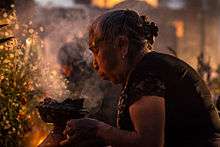
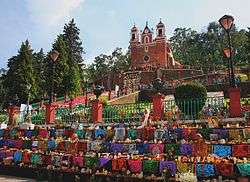
The Day of the Dead celebrations in Mexico developed from ancient traditions among its pre-Columbian cultures. Rituals celebrating the deaths of ancestors had been observed by these civilizations perhaps for as long as 2,500–3,000 years.[14] The festival that developed into the modern Day of the Dead fell in the ninth month of the Aztec calendar, about the beginning of August, and was celebrated for an entire month. The festivities were dedicated to the goddess[15] known as the "Lady of the Dead", corresponding to the modern La Calavera Catrina.
By the late 20th century in most regions of Mexico, practices had developed to honor dead children and infants on November 1, and to honor deceased adults on November 2. November 1 is generally referred to as Día de los Inocentes ("Day of the Innocents") but also as Día de los Angelitos ("Day of the Little Angels"); November 2 is referred to as Día de los Muertos or Día de los Difuntos ("Day of the Dead").[16]
In the 2015 James Bond film, Spectre, the opening sequence features a Day of the Dead parade in Mexico City. At the time, no such parade took place in Mexico City; one year later, due to the interest in the film and the government desire to promote the pre-Hispanic Mexican culture, the federal and local authorities decided to organize an actual "Día de Muertos" parade through Paseo de la Reforma and Centro Historico on October 29, 2016, which was attended by 250,000 people.[17][18][19] This is an example of the pizza effect.
Beliefs
Frances Ann Day summarizes the three-day celebration, the Day of the Dead:
On October 31, All Hallows Eve, the children make a children's altar to invite the angelitos (spirits of dead children) to come back for a visit. November 1 is All Saints Day, and the adult spirits will come to visit. November 2 is All Souls Day, when families go to the cemetery to decorate the graves and tombs of their relatives. The three-day fiesta is filled with marigolds, the flowers of the dead; muertos (the bread of the dead); sugar skulls; cardboard skeletons; tissue paper decorations; fruit and nuts; incense, and other traditional foods and decorations.
— Frances Ann Day, Latina and Latino Voices in Literature[8]
Altars (ofrendas)
People go to cemeteries to be with the souls of the departed and build private altars containing the favorite foods and beverages, as well as photos and memorabilia, of the departed. The intent is to encourage visits by the souls, so the souls will hear the prayers and the comments of the living directed to them. Celebrations can take a humorous tone, as celebrants remember funny events and anecdotes about the departed.[16]
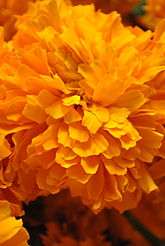

Plans for the day are made throughout the year, including gathering the goods to be offered to the dead. During the three-day period families usually clean and decorate graves;[15] most visit the cemeteries where their loved ones are buried and decorate their graves with ofrendas (altars), which often include orange Mexican marigolds (Tagetes erecta) called cempasúchil (originally named cempōhualxōchitl, Nāhuatl for 'twenty flowers'). In modern Mexico the marigold is sometimes called Flor de Muerto ('Flower of Dead'). These flowers are thought to attract souls of the dead to the offerings. It is also believed the bright petals with a strong scent can guide the souls from cemeteries to their family homes.[20][21]
Toys are brought for dead children (los angelitos, or 'the little angels'), and bottles of tequila, mezcal or pulque or jars of atole for adults. Families will also offer trinkets or the deceased's favorite candies on the grave. Some families have ofrendas in homes, usually with foods such as candied pumpkin, pan de muerto ('bread of dead'), and sugar skulls; and beverages such as atole. The ofrendas are left out in the homes as a welcoming gesture for the deceased.[15][21] Some people believe the spirits of the dead eat the "spiritual essence" of the ofrendas' food, so though the celebrators eat the food after the festivities, they believe it lacks nutritional value. Pillows and blankets are left out so the deceased can rest after their long journey. In some parts of Mexico, such as the towns of Mixquic, Pátzcuaro and Janitzio, people spend all night beside the graves of their relatives. In many places, people have picnics at the grave site, as well.
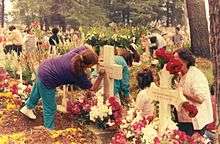
Some families build altars or small shrines in their homes;[15] these sometimes feature a Christian cross, statues or pictures of the Blessed Virgin Mary, pictures of deceased relatives and other people, scores of candles, and an ofrenda. Traditionally, families spend some time around the altar, praying and telling anecdotes about the deceased. In some locations, celebrants wear shells on their clothing, so when they dance, the noise will wake up the dead; some will also dress up as the deceased.
Food
During Day of the Dead festivities, food is both eaten by living people and given to the spirits of their departed ancestors as ofrendas ('offerings').[22] Tamales are one of the most common dishes prepared for this day for both purposes.[23]
Pan de muerto and calaveras are associated specifically with Day of the Dead. Pan de muerto is a type of sweet roll shaped like a bun, topped with sugar, and often decorated with bone-shaped pieces of the same pastry.[24] Calaveras, or sugar skulls, display colorful designs to represent the vitality and individual personality of the departed.[23]
In addition to food, drink is also important to the tradition of Day of the Dead. Historically, the main alcoholic drink was pulque while today families will commonly drink the favorite beverage of their deceased ancestors.[23] Other drinks associated with the holiday are atole and champurrado, warm, thick, non-alcoholic masa drinks.
Jamaican iced tea is a popular herbal tea made of the flowers and leaves of the Jamaican hibiscus plant (Hibiscus sabdariffa), known as flor de Jamaica in Mexico. It is served cold and quite sweet with a lot of ice. The ruby-red beverage is called hibiscus tea in English-speaking countries and called agua de Jamaica (water of hibiscus) in Spanish.[25]
Calaveras
Those with a distinctive talent for writing sometimes create short poems, called calaveras literarias (skulls literature), mocking epitaphs of friends, describing interesting habits and attitudes or funny anecdotes.[26] This custom originated in the 18th or 19th century after a newspaper published a poem narrating a dream of a cemetery in the future, "and all of us were dead", proceeding to read the tombstones. Newspapers dedicate calaveras to public figures, with cartoons of skeletons in the style of the famous calaveras of José Guadalupe Posada, a Mexican illustrator.[27] Theatrical presentations of Don Juan Tenorio by José Zorrilla (1817–1893) are also traditional on this day.

Posada created what might be his most famous print, he called the print La Calavera Catrina ("The Elegant Skull") as a parody of a Mexican upper-class female. Posada's intent with the image was to ridicule the others that would claim the culture of the Europeans over the culture of the indigenous people. The image was a skeleton with a big floppy hat decorated with 2 big feathers and multiple flowers on the top of the hat. Posada's striking image of a costumed female with a skeleton face has become associated with the Day of the Dead, and Catrina figures often are a prominent part of modern Day of the Dead observances.[27]
A common symbol of the holiday is the skull (in Spanish calavera), which celebrants represent in masks, called calacas (colloquial term for skeleton), and foods such as sugar or chocolate skulls, which are inscribed with the name of the recipient on the forehead. Sugar skulls can be given as gifts to both the living and the dead.[27] Other holiday foods include pan de muerto, a sweet egg bread made in various shapes from plain rounds to skulls, often decorated with white frosting to look like twisted bones.[21]
Local traditions
The traditions and activities that take place in celebration of the Day of the Dead are not universal, often varying from town to town. For example, in the town of Pátzcuaro on the Lago de Pátzcuaro in Michoacán, the tradition is very different if the deceased is a child rather than an adult. On November 1 of the year after a child's death, the godparents set a table in the parents' home with sweets, fruits, pan de muerto, a cross, a rosary (used to ask the Virgin Mary to pray for them) and candles. This is meant to celebrate the child's life, in respect and appreciation for the parents. There is also dancing with colorful costumes, often with skull-shaped masks and devil masks in the plaza or garden of the town. At midnight on November 2, the people light candles and ride winged boats called mariposas (butterflies) to Janitzio, an island in the middle of the lake where there is a cemetery, to honor and celebrate the lives of the dead there.
In contrast, the town of Ocotepec, north of Cuernavaca in the State of Morelos, opens its doors to visitors in exchange for veladoras (small wax candles) to show respect for the recently deceased. In return the visitors receive tamales and atole. This is done only by the owners of the house where someone in the household has died in the previous year. Many people of the surrounding areas arrive early to eat for free and enjoy the elaborate altars set up to receive the visitors.
In some parts of the country (especially the cities, where in recent years other customs have been displaced) children in costumes roam the streets, knocking on people's doors for a calaverita, a small gift of candies or money; they also ask passersby for it. This relatively recent custom is similar to that of Halloween's trick-or-treating in the United States. Another peculiar tradition involving children is La Danza de los Viejitos (the dance of the old men) when boys and young men dressed like grandfathers crouch and jump in an energetic dance.[28]
Observances outside of Mexico
Americas
Belize
In Belize, Day of the Dead is practiced by people of the Yucatec Maya ethnicity. The celebration is known as Hanal Pixan which means 'food for the souls' in their language. Altars are constructed and decorated with food, drinks, candies, and candles put on them.
Bolivia
Día de las Ñatitas ("Day of the Skulls") is a festival celebrated in La Paz, Bolivia, on May 5. In pre-Columbian times indigenous Andeans had a tradition of sharing a day with the bones of their ancestors on the third year after burial. Today families keep only the skulls for such rituals. Traditionally, the skulls of family members are kept at home to watch over the family and protect them during the year. On November 9, the family crowns the skulls with fresh flowers, sometimes also dressing them in various garments, and making offerings of cigarettes, coca leaves, alcohol, and various other items in thanks for the year's protection. The skulls are also sometimes taken to the central cemetery in La Paz for a special Mass and blessing.[29][30][31]
Brazil
The Brazilian public holiday of Finados (Day of the Dead) is celebrated on November 2. Similar to other Day of the Dead celebrations, people go to cemeteries and churches with flowers and candles and offer prayers. The celebration is intended as a positive honoring of the dead. Memorializing the dead draws from indigenous, African and European Catholic origins.
Costa Rica
Costa Rica celebrates Día De Los Muertos on November 2nd. The day is also called Día de Todos Santos (All Saints Day) and Día de Todos Almas (All Souls Day). Catholic masses are celebrated and people visit their loved ones' graves to decorate them with flowers and candles.[32]
Ecuador
In Ecuador the Day of the Dead is observed to some extent by all parts of society, though it is especially important to the indigenous Kichwa peoples, who make up an estimated quarter of the population. Indigena families gather together in the community cemetery with offerings of food for a day-long remembrance of their ancestors and lost loved ones. Ceremonial foods include colada morada, a spiced fruit porridge that derives its deep purple color from the Andean blackberry and purple maize. This is typically consumed with wawa de pan, a bread shaped like a swaddled infant, though variations include many pigs—the latter being traditional to the city of Loja. The bread, which is wheat flour-based today, but was made with masa in the pre-Columbian era, can be made savory with cheese inside or sweet with a filling of guava paste. These traditions have permeated mainstream society, as well, where food establishments add both colada morada and gaugua de pan to their menus for the season. Many non-indigenous Ecuadorians visit the graves of the deceased, cleaning and bringing flowers, or preparing the traditional foods, too.[33]
Guatemala
Guatemalan celebrations of the Day of the Dead, on November 1, are highlighted by the construction and flying of giant kites.[34] Guatemalans fly kites in the belief that the kites help the spirits find their way back to Earth. A few kites have notes for the dead attached to the strings of the kites. The kites are used as a kind of telecommunication to heaven.[27] A big event also is the consumption of fiambre, which is made only for this day during the year.[27] In addition to the traditional visits to grave sites of ancestors, the tombs and graves are decorated with flowers, candles, and food for the dead. In a few towns, Guatemalans repair and repaint the cemetery with vibrant colors to bring the cemetery to life. They fix things that have gotten damaged over the years or just simply need a touch-up, such as wooden grave cross markers. They also lay flower wreaths on the graves. Some families have picnics in the cemetery.[27]
Peru
Usually people visit the cemetery and bring flowers to decorate the graves of dead relatives. Sometimes people play music at the cemetery.[35]
United States
.jpg)

In many U.S. communities with Mexican residents, Day of the Dead celebrations are very similar to those held in Mexico. In some of these communities, in states such as Texas,[36] New Mexico,[37] and Arizona,[38] the celebrations tend to be mostly traditional. The All Souls Procession has been an annual Tucson, Arizona, event since 1990. The event combines elements of traditional Day of the Dead celebrations with those of pagan harvest festivals. People wearing masks carry signs honoring the dead and an urn in which people can place slips of paper with prayers on them to be burned.[39] Likewise, Old Town San Diego, California, annually hosts a traditional two-day celebration culminating in a candlelight procession to the historic El Campo Santo Cemetery.[40]
The festival also is held annually at historic Forest Hills Cemetery in Boston's Jamaica Plain neighborhood. Sponsored by Forest Hills Educational Trust and the folkloric performance group La Piñata, the Day of the Dead festivities celebrate the cycle of life and death. People bring offerings of flowers, photos, mementos, and food for their departed loved ones, which they place at an elaborately and colorfully decorated altar. A program of traditional music and dance also accompanies the community event.
The Smithsonian Institution, in collaboration with the University of Texas at El Paso and Second Life, have created a Smithsonian Latino Virtual Museum and accompanying multimedia e-book: Día de los Muertos: Day of the Dead. The project's website contains some of the text and images which explain the origins of some of the customary core practices related to the Day of the Dead, such as the background beliefs and the offrenda (the special altar commemorating one's deceased loved one).[41] The Made For iTunes multimedia e-book version provides additional content, such as further details; additional photo galleries; pop-up profiles of influential Latino artists and cultural figures over the decades; and video clips[42] of interviews with artists who make Día de Muertos-themed artwork, explanations and performances of Aztec and other traditional dances, an animation short that explains the customs to children, virtual poetry readings in English and Spanish.[43][44]
California
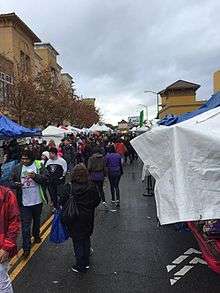
Santa Ana, California, is said to hold the "largest event in Southern California" honoring Día de Muertos, called the annual Noche de Altares, which began in 2002.[45] The celebration of the Day of the Dead in Santa Ana has grown to two large events with the creation of an event held at the Santa Ana Regional Transportation Center for the first time on November 1, 2015.[46]
In other communities, interactions between Mexican traditions and American culture are resulting in celebrations in which Mexican traditions are being extended to make artistic or sometimes political statements. For example, in Los Angeles, California, the Self Help Graphics & Art Mexican-American cultural center presents an annual Day of the Dead celebration that includes both traditional and political elements, such as altars to honor the victims of the Iraq War, highlighting the high casualty rate among Latino soldiers. An updated, intercultural version of the Day of the Dead is also evolving at Hollywood Forever Cemetery.[47] There, in a mixture of Native Californian art, Mexican traditions and Hollywood hip, conventional altars are set up side by side with altars to Jayne Mansfield and Johnny Ramone. Colorful native dancers and music intermix with performance artists, while sly pranksters play on traditional themes.
Similar traditional and intercultural updating of Mexican celebrations are held in San Francisco. For example, the Galería de la Raza, SomArts Cultural Center, Mission Cultural Center, de Young Museum and altars at Garfield Square by the Marigold Project.[48] Oakland is home to Corazon Del Pueblo in the Fruitvale district. Corazon Del Pueblo has a shop offering handcrafted Mexican gifts and a museum devoted to Day of the Dead artifacts. Also, the Fruitvale district in Oakland serves as the hub of the Día de Muertos annual festival which occurs the last weekend of October. Here, a mix of several Mexican traditions come together with traditional Aztec dancers, regional Mexican music, and other Mexican artisans to celebrate the day.[49]
Asia and Oceania
Mexican-style Day of the Dead celebrations occur in major cities in Australia, Fiji, and Indonesia. Additionally, prominent celebrations are held in Wellington, New Zealand, complete with altars celebrating the deceased with flowers and gifts.[50] In the Philippines "Undás", "Araw ng mga Yumao" (Tagalog: "Day of those who have died"), coincides with the Roman Catholic's celebration of All Saints' Day and continues on to the following day: All Souls' Day. Filipinos traditionally observe this day by visiting the family dead to clean and repair their tombs. Offerings of prayers, flowers, candles,[51] and even food, while Chinese Filipinos additionally burn joss sticks and joss paper (kim). Many also spend the day and ensuing night holding reunions at the cemetery, having feasts and merriment.
Europe
As part of a promotion by the Mexican embassy in Prague, Czech Republic, since the late 20th century, some local citizens join in a Mexican-style Day of the Dead. A theater group conducts events involving candles, masks, and make-up using luminous paint in the form of sugar skulls.[52][53]
See also
References
- Society, National Geographic (October 17, 2012). "Dia de los Muertos". National Geographic Society. Retrieved April 8, 2019.
- "Indigenous festivity dedicated to the dead". UNESCO. Archived from the original on October 11, 2014. Retrieved October 31, 2014.
- "Dia de los Muertos". El Museo del Barrio. Archived from the original on October 27, 2015. Retrieved October 31, 2015.
- "Austin Days of the Dead". Archived from the original on November 1, 2015. Retrieved October 31, 2015.
- "Honoring Traditions on Día de Muertos". Dollars & Sense. Baruch College. Retrieved November 14, 2019.
According to Aguirre, Día de los Muertos ... is a direct translation from the English translation of Día de Muertos. Día de los Muertos is simply an American translation, while folks in Mexico refer to the celebration without the “los”.
- Morales, Areli (October 29, 2019). "Read This Before Celebrating Día de Muertos This Year. Signed, a Zapotecan-American". L.A. TACO. Retrieved November 14, 2019.
Dia de Los Muertos is the direct translation of Day of the Dead, the los is not needed.
- "Giant Skeletons Emerge from the Streets of Mexico for Día de los Muertos". My Modern Met. October 31, 2019. Retrieved November 14, 2019.
...when Mexico begins celebrations for Día de los Muertos (better known in Mexico as Día de Muertos).
- Day, Frances Ann (2003). Latina and Latino Voices in Literature. Greenwood Publishing Group. p. 72. ISBN 978-0313323942.
- Lumaban, Weely A. (October–November 2008). "All Soul's Day". The Bread Basket. Vol. V no. 3. Rex Bookstore, Inc. pp. 23–23.
- "Dia de los Muertos". National Geographic Society. Archived from the original on November 2, 2016. Retrieved November 2, 2016.
- Lee, Stacy (2002). Mexico and the United States. Marshall Cavendish. ISBN 978-0761474029.
- Cazares, Eduardo (November 2, 2015). "Día de Muertos en Nuevo León". Diario Cultura. Diario Cultura.mx. Archived from the original on November 1, 2014. Retrieved November 1, 2014.
- Mendoza, Gustavo. "Hasta en el velorio, las penas con pan son menos". Milenio. Archived from the original on October 25, 2016. Retrieved November 1, 2014.
- Miller, Carlos (2005). "History: Indigenous people wouldn't let 'Day of the Dead' die". The Arizona Republic. Day of the Dead – Día De Los Muertos. Retrieved November 28, 2007.
- Salvador, R.J. (2003). John D. Morgan and Pittu Laungani (ed.). Death and Bereavement Around the World: Death and Bereavement in the Americas. Death, Value and Meaning Series, Vol. II. Amityville, New York: Baywood Publishing Company. pp. 75–76. ISBN 978-0-89503-232-4.
- Palfrey, Dale Hoyt (1995). "The Day of the Dead". Día de los Muertos Index. Access Mexico Connect. Archived from the original on November 30, 2007. Retrieved November 28, 2007.
- "Mexico City stages first Day of the Dead parade". BBC. October 29, 2016. Archived from the original on October 30, 2016. Retrieved November 1, 2016.
- "Fotogalería: Desfile por Día de Muertos reúne a 250 mil personas". Excélsior (in Spanish). October 29, 2016. Archived from the original on October 31, 2016. Retrieved November 1, 2016.
- "Galerías Archivo". Televisa News. Archived from the original on November 3, 2016. Retrieved November 1, 2016.
- "5 Facts About Día de los Muertos (The Day of the Dead)". Smithsonian Insider. October 30, 2016. Archived from the original on August 29, 2018. Retrieved August 29, 2018.
- Brandes, Stanley (1997). "Sugar, Colonialism, and Death: On the Origins of Mexico's Day of the Dead". Comparative Studies in Society and History. 39 (2): 275. ISSN 0010-4175. JSTOR 179316.
- Turim, Gayle (November 2, 2012). "Day of the Dead Sweets and Treats". History Stories. History Channel. Archived from the original on June 6, 2015. Retrieved July 1, 2015.
- Godoy, Maria. "Sugar Skulls, Tamales And More: Why Is That Food On The Day Of The Dead Altar?". NPR. Archived from the original on October 28, 2017. Retrieved October 25, 2017.
- Castella, Krystina (October 2010). "Pan de Muerto Recipe". Epicurious. Archived from the original on July 8, 2015. Retrieved November 2, 2019.
- "Jamaica iced tea". Cooking in Mexico. Archived from the original on November 4, 2011. Retrieved October 23, 2011.
- "These wicked Day of the Dead poems don't spare anyone". PBS NewsHour. November 2, 2018. Retrieved May 6, 2019.
- Marchi, Regina M (2009). Day of the Dead in the USA : The Migration and Transformation of a Cultural Phenomenon. New Brunswick: Rutgers University Press. p. 17. ISBN 978-0-8135-4557-8.
- "Día de los Muertos or Day of the Dead". Archived from the original on August 29, 2018. Retrieved August 29, 2018.
- Guidi, Ruxandra (November 9, 2007). "Las Natitas". BBC. Archived from the original on December 6, 2008.
- Smith, Fiona (November 8, 2005). "Bolivians Honor Skull-Toting Tradition". Associated Press. Archived from the original on February 18, 2008. Retrieved December 30, 2007.
- "All Saints day in Bolivia – "The skull festival"". Bolivia Line (May 2005). Archived from the original on October 23, 2008. Retrieved December 20, 2007.
- Costa Rica Celebrates The Day of the Dead Outward Bound Costa Rica, 2012-11-01.
- Ortiz, Gonzalo (October 30, 2010). "Diversity in Remembering the Dead". InterPress Service News Agency. Archived from the original on November 4, 2010. Retrieved October 30, 2010.
- Burlingame, Betsy; Wood, Joshua. "Visit to cemetery in Guatemala". Expatexchange.com. Archived from the original on October 14, 2007. Retrieved August 13, 2009.
- "Perú: así se vivió Día de todos los santos en cementerios de Lima". Peru. peru.com. January 1, 2016. Archived from the original on November 7, 2017. Retrieved October 30, 2017.
- Wise, Danno. "Port Isabel's Day of the Dead Celebration". Texas Travel. About.com. Archived from the original on December 9, 2007. Retrieved November 28, 2007.
- "Dia de los Muertos". visitalbuquerque.org. Archived from the original on November 3, 2016. Retrieved November 1, 2016.
- Hedding, Judy. "Day of the Dead". Phoenix. About.com. Archived from the original on December 11, 2007. Retrieved November 28, 2007.
- White, Erin (November 5, 2006). "All Souls Procession". Arizona Daily Star. Archived from the original on November 6, 2012. Retrieved November 28, 2007.
- "Old Town San Diego's Dia de los Muertos". Archived from the original on November 7, 2014. Retrieved October 19, 2014.
- Smithsonian Latino Virtual Museum. Día de los Muertos: Day of the Dead (Version 1.2 ed.). Archived from the original on December 22, 2014. Retrieved October 31, 2014.
- "Smithsonian Latino Virtual Museum". Ustream. Archived from the original on October 31, 2014. Retrieved October 31, 2014.
- Smithsonian Latino Virtual Museum. "Day of the Dead". Theater of the Dead. Archived from the original on November 12, 2014. Retrieved October 31, 2014.
- Smithsonian Institution. "Smithsonian-UTEP Día de los Muertos Festival: A 2D and 3D Experience!". Smithsonian Latino Virtual Museum Press Release. Archived from the original on November 6, 2009.
- "Less-scary holiday: Some faith groups offer alternatives to Halloween trick-or-treating". The Orange County Register. Archived from the original on October 31, 2015. Retrieved November 2, 2015.
- "Viva la Vida or Noche de Altares? Santa Ana's downtown division fuels dueling Day of the Dead events". The Orange County Register. Archived from the original on November 3, 2015. Retrieved November 2, 2015.
- Quinones, Sam (October 28, 2006). "Making a night of Day of the Dead". Los Angeles Times. Retrieved November 26, 2006.
- "Dia de los Muertos [Day of the Dead] – San Francisco". Archived from the original on October 17, 2014. Retrieved October 19, 2014.
- Elliott, Vicky (October 27, 2000). "Lively Petaluma festival marks Day of the Dead". The San Francisco Chronicle. Archived from the original on July 8, 2012. Retrieved August 6, 2010.
- "Day of the Dead in Wellington, New Zealand". Scoop.co.nz. October 27, 2007. Archived from the original on June 4, 2009. Retrieved August 13, 2009.
- "All Saints Day around the world". Guardian Weekly. November 1, 2010. Archived from the original on October 29, 2018. Retrieved October 30, 2018.
- "48 Best Sugar Skull Makeup Creations To Day of the Dead". Retrieved October 14, 2019.
- "Day of the Dead in Prague". Radio Czech. October 24, 2007. Archived from the original on October 24, 2007.
Further reading
| Wikimedia Commons has media related to Day of the Dead. |
- Andrade, Mary J. Day of the Dead A Passion for Life – Día de los Muertos Pasión por la Vida. La Oferta Publishing, 2007. ISBN 978-0-9791624-04
- Anguiano, Mariana, et al. Las tradiciones de Día de Muertos en México. Mexico City 1987.
- Brandes, Stanley (1997). "Sugar, Colonialism, and Death: On the Origins of Mexico's Day of the Dead". Comparative Studies in Society and History. 39 (2): 270–99. doi:10.1017/S0010417500020624.
- Brandes, Stanley (1998). "The Day of the Dead, Halloween, and the Quest for Mexican National Identity". Journal of American Folklore. 111 (442): 359–80. doi:10.2307/541045. JSTOR 541045.
- Brandes, Stanley (1998). "Iconography in Mexico's Day of the Dead". Ethnohistory. Duke University Press. 45 (2): 181–218. doi:10.2307/483058. JSTOR 483058.
- Brandes, Stanley (December 15, 2006). Skulls to the Living, Bread to the Dead. Blackwell Publishing. p. 232. ISBN 978-1-4051-5247-1.
- Cadafalch, Antoni. The Day of the Dead. Korero Books, 2011. ISBN 978-1-907621-01-7
- Carmichael, Elizabeth; Sayer, Chloe. The Skeleton at the Feast: The Day of the Dead in Mexico. Great Britain: The Bath Press, 1991. ISBN 0-7141-2503-2
- Conklin, Paul (2001). "Death Takes a Holiday". U.S. Catholic. 66: 38–41.
- Garcia-Rivera, Alex (1997). "Death Takes a Holiday". U.S. Catholic. 62: 50.
- Haley, Shawn D.; Fukuda, Curt. Day of the Dead: When Two Worlds Meet in Oaxaca. Berhahn Books, 2004. ISBN 1-84545-083-3
- Lane, Sarah and Marilyn Turkovich, Días de los Muertos/Days of the Dead. Chicago 1987.
- Lomnitz, Claudio. Death and the Idea of Mexico. Zone Books, 2005. ISBN 1-890951-53-6
- Matos Moctezuma, Eduardo, et al. "Miccahuitl: El culto a la muerte," Special issue of Artes de México 145 (1971)
- Nutini, Hugo G. Todos Santos in Rural Tlaxcala: A Syncretic, Expressive, and Symbolic Analysis of the Cult of the Dead. Princeton 1988.
- Oliver Vega, Beatriz, et al. The Days of the Dead, a Mexican Tradition. Mexico City 1988.
- Roy, Ann (1995). "A Crack Between the Worlds". Commonwealth. 122: 13–16.

